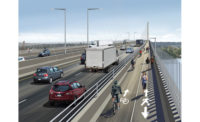Roadways that cross wildlife habitats either create a barrier for animals or, if they try to cross them, a danger for both themselves and passing vehicles. Now, with $350 million in Infrastructure Investment and Jobs Act funding for their construction poised to roll out in 2023—along with increased funding from states—wildlife crossings built both over and under roadways may soon grow in popularity.
One recent example, found in Washington's Cascade Mountains, is a wildlife crossing spanning Interstate 90, running about 215-ft long and about 150-ft wide. Upon opening in 2018, the $6-million overpass was the largest such structure in North America, according to Washington State Dept. of Transportation (WSDOT). Since then, it has proven a key connector for wildlife to nearby Keechelus Lake, providing safe passage for elk, deer, bobcat and cougars. Vehicle collusions involving wildlife on the corridor have plummeted between 80% and 99% since it went into operation, according to WSDOT.
Washington plans to build more, as do other states. Data rolling in about the economic and ecological benefits is helping promote the benefits of wildlife crossings.
"At a basic level, these structures provide a win-win for humans and wildlife alike, measured in foregone mortality events as well as in economic terms," says Matt Skroch, The Pew Charitable Trusts project director for U.S. public lands and rivers conservation. "By facilitating wildlife movement away from the lanes of traffic—either above or below grade—we see less human injury or death, less wildlife loss and more resilient ecosystems due to improved landscape connectivity."
With the Federal Highway Administration estimating between one and two million vehicle-animal strikes each year, causing over $8.3 billion in related costs, the double-pronged economic and ecological efforts are evident.
"Engineers bear responsibility to offer solutions when designing new roadways, bridges and structures that allow for the safe passage of animals in their natural environments," says Kevin Hetrick, Central Indiana area manager for engineering firm Clark Dietz.
Call of the Wild
Across the U.S., wildlife crossings have been utilized by various entities for decades. From the desert tortoise in Southern California to the panther in Florida, the use of wildlife crossings has expanded, most commonly in underpass form.
Florida now has around 60 wildlife crossings and has been building land bridges—including overpasses along Interstate 75 and I-95—for more than two decades. Utah has more than 50 wildlife underpasses and built its first overpass in 2019 with a 350-ft-long and 150-ft-wide crossing. North Carolina is undergoing a push for dedicated wildlife crossings, including the 2021 construction of one such overpass to help black bears, elk and whitetail deer migrate across the highway. Indiana is exploring the wildlife crossing effort for smaller mammals.
Skroch says that every state he's working with has shown enthusiasm for the new IIJA pilot program that provides $350 million for wildlife crossings. The FHWA has yet to get the program rolling, but he expects a grant application window in 2023 will bring considerable competition for those dollars. "States are dedicating their own money to wildlife crossings as well," he says. "Legislatures in seven Western states appropriated tens of millions of dollars just this year, and we expect more to do so in 2023."
Skroch adds that the recent increased interest in wildlife crossings as an engineered solution for this problem "has led to increased integration into standard transportation, engineering and planning protocols at federal, state and tribal transportation agencies, ultimately leading to the construction of many more in coming years."
A 2020 USDA study concluded that wildlife crossing bridges, followed by shared-use viaducts and large fauna tunnels, are most effective in providing wildlife safe passage away from traffic. The latest research, Skroch says, favors wildlife overpasses as the safest option for the widest range of species. Some animals, including large pronghorn or bighorn sheep, avoid underpasses with long, dark passageways, although underpasses with clear views of the other side may be attractive.
"Well-designed wildlife crossing interventions are shown to reduce large-animal mortality and wildlife-vehicle collisions by 80% to 95%," he says. Site-specific monitoring reports prove this out. A State Highway 9 project in Colorado shows more than 100,000 successful wildlife crossings and a 90% reduction in mortality with a 92% decline in wildlife-vehicle collisions. A Nevada Dept. of Transportation report documented more than 35,000 mule deer using several crossings along U.S. 93, showing decreased mortality each year as the herd acclimated to using the crossing structures over time.
Over and Under
The 11 large crossings on Washington's I-90 include underpasses, such as the Gold Creek Underpass, a viaduct that is larger than the overpass to span wetlands. "All the structures in the Snoqualmie Pass East area have been incredibly effective," says Glen Kalisz, WSDOT habitat connectivity biologist. Not only have safe wildlife crossings grown year over year—and are projected to continue growth in 2022—but wildlife collisions have dropped to nearly zero in the completed project areas.
The primary overpass includes fencing to help funnel animals toward the bridge. Data shows that elk, traditionally slow adopters, nearly doubled their rate of usage in 2021 versus 2020.
"Combining fencing with suitable crossing structures—wildlife over- or under-passes—reduces the tendency for animals to run around the end of the fences," the Washington State Dept of Transportation writes. "They learn to use these crossing structures to pass safely to the other side of the road."
Andrea Wolf-Buck, spokesperson for Conservation Northwest, says a Highway 97 wildlife crossing the group worked on in north central Washington that included an undercrossing and one mile of deer fence, has reduced vehicle-deer collisions 91% in two years. Before the crossing project, estimates showed more than 350 deer were hit by cars in a 12.5-mile stretch of the highway each year. Another one of six planned underpasses in the same area was recently approved.
"We're thrilled to see that the state is prioritizing more wildlife crossings around Washington and we're working with our partners to help find the locations best suited for an underpass," Wolf-Buck says. "We also have big dreams of seeing better connectivity around the Interstate-5 corridor and Highway 12. Increasing wildlife mobility in southwest Washington is critical for opening a safe passage for animals from the Cascades to the Olympics."
Washington state has 22 wildlife bridges and underpasses, half in Kittitas County, where Interstate 90 bisects the Cascade Mountains. Kalisz says they are looking to add structures at multiple locations, but it's a long process. He expects at least seven more large wildlife crossing structures will be built in the remaining phases of construction along I-90. State Route 20 will get a wildlife underpass in the next few years and work continues along U.S. 97.
"The legislature allocated $2.7 million to use as matching funds to compete for federal dollars to complete this project," Kalisz says, "and we are currently trying to secure those federal funds. There are many other habitat-connectivity priorities across the state, and we're working to build justification, research and our funding bucket to address them."
Farther Afield
California recently began work on an overpass even more ambitious than Washington’s I-90 span—the $90-million Wallis Annenberg Wildlife Crossing in western Los Angeles County. When completed in 2025, the overpass will span 10 lanes across the 101 Freeway. At 210-ft long and 174-ft wide, it will encompass 12 acres.
The project is designed to provide safe passage across the mega-freeway for wildlife such as mountain lions, bobcats, birds and lizards.
"The crossing is a giant green roof on steroids," says Robert Rock, Living Habitats Principal and COO. "We are taking this green fabric and stretching it across the freeway and connecting it to both sides and what we are effectively doing is sticking together an ecosystem across the freeway."
"If lawmakers make it a priority to put wildlife crossings in the state's most problematic hot spots, that'll make a huge difference in protecting imperiled species," Tiffany Yap, Center for Biological Diversity scientist, said in a news release supporting new legislation in California requiring wildlife crossings.
The benefits of wildlife crossings aren't just ecological. A Washington State University economic analysis found there were one to three fewer collisions involving wildlife per mile each year in a 10-mile radius around each wildlife crossing in the study, saving about $440,000 per structure annually. "Wildlife crossing structures not only benefit the ecosystem but may also improve road safety," says Wisnu Sugiarto, a WSU economics doctoral student and author of a published study.
Analyzing collision data from the state, Sugiarto found that the addition of wildlife bridges provided consistent, significant reductions in collisions. "From a driver's point of view, they may choose to drive safely, but still, unfortunately, there are animals that cross the road, and they end up hitting them," he says. "This shows there's something we can do about these collisions."
"We're only beginning to scratch the surface," Skroch says, "on how to best reduce the ecological impacts of our transportation system on those and many other species."





Post a comment to this article
Report Abusive Comment